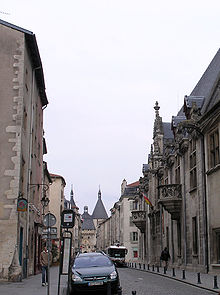- Palace of the Dukes of Lorraine
-
Coordinates: 48°41′49″N 6°10′49″E / 48.69694°N 6.18028°E
The Ducal Palace of Nancy or Palais ducal du Nancy is a palace in Nancy, France, which was home to the Dukes of Lorraine. It houses the Musée Lorrain, one of Nancy's principal museums, dedicated to the art, history and popular traditions of Lorraine until the early 20th century.[1]
Contents
History
The palace was built in the 15th century for René II, Duke of Lorraine[2].
In the 18th century the palace was extended by Baroque architects. Under the rule of Leopold, Duke of Lorraine parts of the building were pulled down, in preparation of greater projects, he intended. After the House of Habsburg had given Lorraine under French control in change for Tuscany, the ducal palace in Nancy became the home of Stanisław Leszczyński[3]. After Stanisław's death, his Duchy was inherited by his son-in-law, King Louis XV of France and incorporated in his dominions.
The first level of the structure contains reception and dining rooms used by the Dukes, known as the Galerie des Cerfs. On the ground floor, there is an open-vaulted gallery overlooking the garden, while a portal marks the Grande Rue entrance. Also built in Gothic style, its décor suggests that it is one of the earliest examples of work from the Renaissance period in nowaday's eastern France.
Musée Lorrain
In 1848 the palace was converted to house the Musée Lorrain[4]. The museum's collections include artefacts from the Gallo-Roman and Merovingian civilisations of the east of France, religious and funeral sculptures and stained-glass windows from the Medieval period, as well as armaments from the 14th and 15th centuries. The museum also includes a collection of Renaissance art including works by Ligier Richier and sculptures relating to the history of the Palace itself, as well as of major works by Georges de la Tour and Jacques Callot.
See also
- Museum of Fine Arts of Nancy
- Palace of the Dukes of Burgundy
- Grand Ducal Palace, Luxembourg
References
External links
 Media related to Palais des Ducs de Lorraine at Wikimedia CommonsCategories:
Media related to Palais des Ducs de Lorraine at Wikimedia CommonsCategories:- Palaces in France
- Art museums and galleries in France
- Nancy
- Official historical monuments of France
Wikimedia Foundation. 2010.

